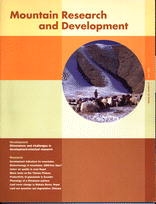In November 1998, the United Nations General Assembly designated 2002 as the International Year of Mountains (IYM2002), thus underscoring the international community's increasing recognition of the importance of mountain issues. The United Nations University (UNU) and the Centre for Development and Environment (CDE) are preparing for IYM2002 and beyond with a new program, the Global Mountain Partnership Program (UNU GMPP).
The framework of the new program was discussed and formulated at a constituent meeting in Tokyo in July 2000, which involved representatives of UNU, CDE, and various Japanese universities and corporations. UNU GMPP will increase UNU's involvement in mountains, which dates from 1978. The goal of the program is to promote sustainable development of mountain systems worldwide and enhance understanding of the increasing problems threatening mountain communities and environments today.
An umbrella program promoting partnerships
UNU GMPP is an umbrella program: it will incorporate existing and future projects that focus on mountain research and meet certain criteria for eligibility. Existing projects and programs may apply for membership in UNU GMPP and take advantage of its features. UNU GMPP will offer basic activities in methodology, institution building, social empowerment, and dissemination of information. These will enhance its members' activities.
For further information about UNU GMPP, please contact the author.
Appendices
APPENDIX I
Eligibility
To apply for membership in UNU GMPP, an applicant must
Be a leading research institution (organization, program, project).
Work in or on mountains or highland–lowland interactions.
Engage in research that focuses on sustainable development.
Apply innovative approaches, such as problem-solving mechanisms, technology development, institutional reform.
Use disciplinary, interdisciplinary, and transdisciplinary (participatory) methodologies.
Include capacity and competence-building components.
Have international visibility and participate in an acknowledged form of exchange of information (eg, international publications or networks).
Guarantee social empowerment through involvement in approaches, methods, and application.
Have a project or program duration of at least 1 year.
Be willing to subject the project/program to annual reporting (UNU guided), annual internal review, and occasional external visits by UNU GMPP representative(s).
APPENDIX II
Benefits
Advantages to members of UNU GMPP include
Being entitled to refer to a project or program as being ‘A Member of UNU's Global Mountain Partnership Program,’ with the corresponding international support and acknowledgment.
Enhancement of a project or program's global visibility (web linkage).
Obtaining regular information on issues related to mountain research and development.
The possibility of publishing results and reports on experience in Mountain Research and Development, the international journal jointly published by UNU and the International Mountain Society (IMS).
Becoming a potential partner institution in joint research programs.
Participating in methodological innovation and development.
Identifying and exploring partnership and collaboration with other members of UNU GMPP.
Exchanging and disseminating information among peers within UNU GMPP.
UNU GMPP will promote strategies leading to sustainable mountain development. For example, the proposed "Pamir Strategy Project" in Tajikistan will be open to collaboration involving many actors from the local to the international level. The project will also benefit the mountain population in and around the regional capital of Khorog. (Photo by Ulrich Lutz, June 2000)






